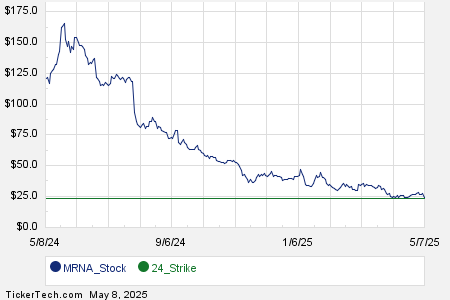Mixed Market Dynamics as Tariff Concerns Weigh on Performance
The S&P 500 Index ($SPX) (SPY) is down -0.09%, while the Dow Jones Industrials Index ($DOWI) (DIA) shows a gain of +0.46%. The Nasdaq 100 Index ($IUXX) (QQQ) has decreased by -0.40%. Additionally, June E-mini S&P futures (ESM25) are down -0.17%, and June E-mini Nasdaq futures (NQM25) are down -0.57%.
Market Sentiment Influenced by Trade Uncertainty
Today’s mixed stock indexes reflect a 2-1/2 week high for the Dow Jones Industrials. However, the broader market faces pressure from ongoing uncertainty surrounding US trade policies, particularly as investors await further clarification on tariff measures ahead of President Trump’s April 2 deadline.
Stocks are also reacting to an unexpected decline in February’s core capital goods new orders, amplifying concerns regarding economic momentum. Furthermore, the performance of the Magnificent Seven stocks has added to the market’s struggles today.
Earlier this week, optimism briefly surged following President Trump’s comments that suggested new tariffs might be more targeted and less expansive than initially feared. He indicated that he would “probably be more lenient than reciprocal” regarding tariff applications.
Mortgage Trends and Economic Indicators
The US MBA’s mortgage applications fell -2.0% for the week ending March 21, with the purchase mortgage sub-index up +0.7% and the refinancing sub-index down -5.3%. The average 30-year fixed mortgage rate slightly decreased by -1 basis point to 6.71% from the prior week’s 6.72%.
In February, core capital goods orders (nondefense, excluding aircraft and parts) unexpectedly fell by -0.3% month-over-month, contrary to expectations of a +0.2% gain. This marks the most significant monthly drop in seven months, reflecting widespread concerns about reduced capital spending due to trade-related uncertainties.
Market Reactions to Fed Comments
Hawkish comments from Chicago Fed President Goolsbee today contributed to stock and bond market pressures. He noted that the Fed may not be on the “golden path” previously experienced in 2023 and 2024, hinting that the next rate cut may take longer than expected due to ongoing macroeconomic uncertainties.
Look for market attention to shift toward Thursday’s Q4 GDP report, expected to remain unchanged at +2.3% (quarter-over-quarter annualized). March pending home sales are anticipated to rise +1.0% month-over-month. Additionally, personal spending data for February is projected at +0.5% growth, with personal income rising +0.4%. The February core PCE price index, the Fed’s preferred inflation measure, is expected to show an increase of +0.3% month-over-month and +2.7% year-over-year. The revised March University of Michigan US consumer sentiment index is expected to remain steady at 57.9.
Geopolitical Tensions Impact Market Stability
Heightened geopolitical risks in the Middle East are contributing to negative stock market sentiment. Israel has renewed airstrikes in Gaza, breaking a two-month ceasefire with Hamas, and Prime Minister Netanyahu has vowed to act “with increasing military strength” as the situation escalates. Additionally, US defense actions against Houthi rebels in Yemen are intensifying geopolitical concerns.
Stock prices have been under pressure over the last three weeks due to fears that US tariffs will hinder economic growth and corporate earnings. Following President Trump’s imposition of 25% tariffs on Canadian and Mexican goods and a doubling of tariffs on Chinese imports—up to 20% from 10%—the market is now bracing for more reciprocal tariffs on April 2.
The market currently estimates a 16% likelihood of a -25 basis point rate cut after the FOMC meeting scheduled for May 6-7.
Global Market Overview
Today, overseas stock markets also reflect mixed signals. The Euro Stoxx 50 is down -0.55%, while China’s Shanghai Composite Index closed with a minimal decrease of -0.04%. Conversely, Japan’s Nikkei 225 climbed, closing up +0.65% at a 3-1/2 week high.
Interest Rate Trends
June 10-year T-notes (ZNM25) are down -6 ticks today, and the yield has increased by +2.3 basis points to 4.336%. The T-notes are facing pressures due to Goolsbee’s hawkish remarks and higher inflation expectations, with the 10-year breakeven inflation rate reaching a 3-week high of 2.375%. Additionally, supply pressures loom as the Treasury plans to auction $70 billion of 5-year T-notes and $28 billion of 2-year floating-rate notes as part of a larger $211 billion auction package this week.
In Europe, bond yields trend downward, with the 10-year German bund yield dropping by -0.2 basis points to 2.796% and the UK gilt yielding down -2.1 basis points to 4.732%.
UK February CPI registered a year-over-year increase of +2.8%, falling short of the anticipated +3.0%, while core CPI rose +3.5%, below expectations of +3.6%. Market swaps indicate a 72% chance of a -25 basis point rate cut by the ECB during its April 17 meeting.
US Stock Movers
Weakness in the Magnificent Seven stocks has continued to weigh on the market. Companies like Amazon.com (AMZN), Meta Platforms (META), Tesla (TSLA), and Alphabet (GOOGL) have all lost more than -1% today. Additionally, Microsoft (MSFT) is down -0.47%.
Nvidia (NVDA) has experienced a significant decline of over -3% following reports that China’s National Development and Reform Commission is advising against the use of Nvidia’s H20 chips in new data centers due to compliance issues with new regulatory standards.
Energy stocks are faring better today due to a rise in the price of WTI crude, reaching a 3-week high. Valero Energy (VLO) and Schlumberger (SLB) have each climbed more than +2%, while other energy companies, including Diamondback Energy (FANG), Haliburton (HAL), Occidental Petroleum (OXY), ConocoPhillips (COP), Exxon Mobil (XOM), and Chevron (CVX), are up more than +1%.
Cintas (CTAS) leads gains in the S&P 500 and Nasdaq 100, rising over +8% after upgrading its full-year EPS estimate to $4.36-$4.40, exceeding the consensus estimate of $4.33.
Conversely, Chewy (CHWY) is down more than -2% after projecting 2026 net sales of $12.30 billion to $12.45 billion, falling below consensus expectations of $12.43 billion.
Dollar Tree (DLTR) climbed more than +3% after finalizing the sale of its Family Dollar chain for approximately $1 billion to Brigade Capital Management and Macellum Capital Management.
CarMax (KMX) has seen a +2% rise following an upgrade from Stephens, which changed its rating to overweight from equal weight, establishing a price target of $90.
JB Hunt Transport Services (JBHT) is down nearly -1% after receiving a downgrade to neutral from positive from Susquehanna Financial.
Upcoming Earnings Reports
Scheduled earnings releases for March 26, 2025, include Cintas Corp (CTAS), Concentrix Corp (CNXC), Dollar Tree Inc (DLTR), Jefferies Financial Group Inc (JEF), and Paychex Inc (PAYX).
On the date of publication, Rich Asplund did not have (either directly or indirectly) positions in any of the securities mentioned in this article. All information and data in this article is solely for informational purposes. For more information, please view the Barchart Disclosure Policy here.
More news from Barchart
The views and opinions expressed herein are those of the author and do not necessarily reflect those of Nasdaq, Inc.


